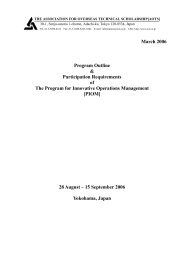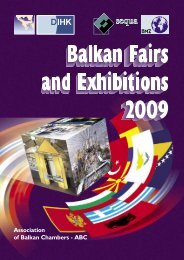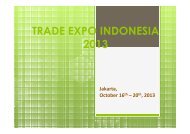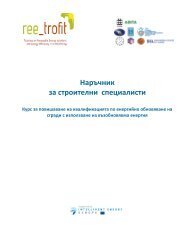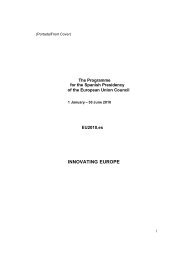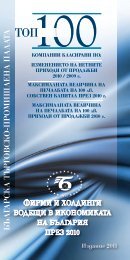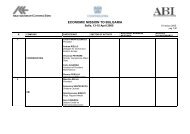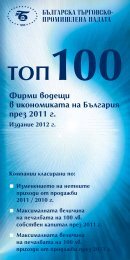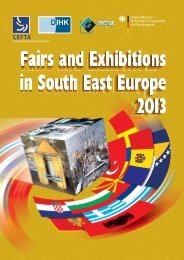Analysis of the Operation and Financial Condition of the Enterprise
Analysis of the Operation and Financial Condition of the Enterprise
Analysis of the Operation and Financial Condition of the Enterprise
Create successful ePaper yourself
Turn your PDF publications into a flip-book with our unique Google optimized e-Paper software.
<strong>Analysis</strong> <strong>of</strong> <strong>the</strong> <strong>Operation</strong> <strong>and</strong> <strong>Financial</strong> <strong>Condition</strong> <strong>of</strong> <strong>the</strong> <strong>Enterprise</strong>like tin pipes, insulation materials are searched in <strong>the</strong> directories <strong>and</strong> any discount isdeducted from <strong>the</strong> reference price specified in <strong>the</strong> directory <strong>of</strong>fered by <strong>the</strong> supplier <strong>of</strong> thosematerials. In cases <strong>of</strong> more specific equipment provided for in <strong>the</strong> project <strong>and</strong> having nost<strong>and</strong>ard <strong>of</strong>fers in <strong>the</strong> directories, <strong>the</strong> suppliers <strong>of</strong> <strong>the</strong>se items <strong>of</strong> equipment are being sent arequest to give <strong>the</strong> price quotation for a specific item <strong>of</strong> goods. The price <strong>of</strong>fered isincluded in <strong>the</strong> project estimate. When <strong>the</strong> estimate <strong>of</strong> all costs involved in <strong>the</strong> execution <strong>of</strong><strong>the</strong> project is approved on behalf <strong>of</strong> <strong>the</strong> building contractor, <strong>the</strong> project supervisor onceagain checks <strong>the</strong> <strong>of</strong>fers <strong>of</strong> <strong>the</strong> prices <strong>and</strong> prepares <strong>the</strong> required budget for <strong>the</strong> realisation <strong>of</strong><strong>the</strong> project within <strong>the</strong> limits <strong>of</strong> which <strong>the</strong> project will be implemented. In <strong>the</strong> course <strong>of</strong>project execution st<strong>and</strong>ard materials are purchased from <strong>the</strong> suppliers <strong>of</strong> materials withwhich <strong>the</strong> respective contracts are signed on sales <strong>of</strong> materials with <strong>the</strong> specific discountsby mentioning also <strong>the</strong> terms <strong>of</strong> payment in <strong>the</strong> contracts. The specific materials, on <strong>the</strong>irturn, are being purchased based on <strong>the</strong> price <strong>of</strong>fer given by <strong>the</strong> suppliers <strong>of</strong> those materials.When in <strong>the</strong> course <strong>of</strong> project execution <strong>the</strong> respective materials are needed <strong>the</strong>construction supervisor prepares <strong>the</strong> list <strong>of</strong> materials required, which is <strong>the</strong>n passed over to<strong>the</strong> supplies manager <strong>of</strong> <strong>the</strong> enterprise, who takes care <strong>of</strong> delivering <strong>the</strong>m directly to <strong>the</strong>site <strong>and</strong> on time. It can be said that <strong>the</strong> enterprise is using <strong>the</strong> 'just-in-time' concept forprovision <strong>of</strong> <strong>the</strong> materials <strong>and</strong> <strong>the</strong>refore no large stock <strong>of</strong> materials is building up in <strong>the</strong>warehouse.5.5.5. Cash resourcesCash assets have <strong>the</strong> highest degree <strong>of</strong> mobility among all current assets. 5.25. Itcan be noticed in Table 5.25 ‘Cash assets <strong>and</strong> <strong>the</strong>ir percentage from total current assets in<strong>the</strong> period from 03/12/2XX8 to 31/12/2XX9’ that <strong>the</strong> amount <strong>of</strong> cash assets is varying,because <strong>the</strong> amount <strong>of</strong> cash available depends on when <strong>the</strong> debtors have paid <strong>the</strong>ir debts. Ifit is <strong>the</strong> same day or one day before <strong>the</strong> end <strong>of</strong> <strong>the</strong> financial period, this amount <strong>of</strong> moneyhas not been probably transferred to <strong>the</strong> creditors yet.Table5.25.Cash assets <strong>and</strong> <strong>the</strong>ir percentage from total current assets <strong>of</strong> <strong>Enterprise</strong> N in<strong>the</strong> period from 03/12/2XX8 to 31/12/2XX9March,2XX8June,2XX8Sept.,2XX8Dec.,2XX8March,2XX9June,2XX9Sept.,2XX9Dec.,2XX9Cash resources 8947 12931 10014 3385 572 2581 1262 8916Changes in cashassets by period -14911 3984 -2917 -6629 -2813 2009 -1319 7654Current assets 210557 241778 343779 318301 476754 386462 296149 304415Percentage <strong>of</strong> cashassets from totalcurrent assets 4,2 5,3 2,9 1,1 0,1 0,7 0,4 2,9It can be concluded from Table 5.25 that <strong>the</strong> amount <strong>of</strong> cash assets at <strong>the</strong> disposal<strong>of</strong> <strong>the</strong> enterprise decreased considerably during <strong>the</strong> period from <strong>the</strong> end <strong>of</strong> December,117



